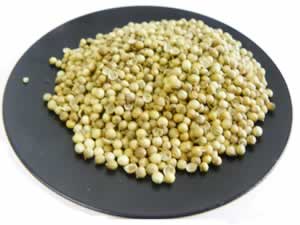Coriander Coriandrum sativum

coriander seeds
- Common Names
- Coriander , Chinese parsley, Cilantro
- Botanical Name
- Coriandrum sativum
- Family
- APIACEAE
Medicinal Uses & Benefits of Coriander
![]() How to Use|
Side Effects |
Plant & Garden|
Aromatherapy Oil |
How to Use|
Side Effects |
Plant & Garden|
Aromatherapy Oil |
- Medicinal Uses: * Aromatherapy
* Ayurvedic
* Culinary/Kitchen
* Digestion
* Immune
* Rheumatoid_arthritis
- Properties: * Analgesic * Carminative * Digestive * Diuretic * Emmenagogue * Febrifuge * Sedative
- Parts Used: seeds, essential oil
How to Use: Coriander
The Coriandrum sativum plant produces both Coriander (seeds) and Cilantro (leaves) Coriander's anti-inflammatory properties can help reduce joint swelling in rheumatoid arthritis, a traditional use that has been recently validated in studies. 6 In Ayurvedic medicine, coriander is considered tridoshic, good for all body types. Fresh cilantro leaves have similar, but weaker properties. 56 When the herb is added to the diet along with other natural immune system boosters like garlic, and omega-3 fatty acids, chronic infections can be eliminated.
Preparation Methods & Dosage :The seeds are referred to as coriander, a key spice in in Indian curries. The seeds lose flavor quickly when ground, it is best to buy whole seeds and grind just before using. Coriander seeds can also be lightly toasted to enhance flavor. In India, roasted seeds are a common snack.
Coriander Remedies
Coriander : Essential Oil Profile
Similar to bergamot, but with a woody nuance, coriander;s scent adds a sweet freshness to soaps and perfumes. .
Ayurvedic Medicine
 The pungent taste and warming carminative properties of coriander are good for kapha.
The pungent taste and warming carminative properties of coriander are good for kapha.
Plant Description

Koehler's Medicinal-Plants 1887
Corriander, also commonly called cilantro, is an annual herb native to southwestern Asia west to north Africa.It is an annual, with erect stems, 1 to 3 feet high, slender and branched. The lowest leaves are stalked and pinnate, the leaflets roundish or oval, slightly lobed. The segments of the uppermost leaves are linear and more divided. The flowers are in shortly-stalked umbels, five to ten rays, pale mauve, almost white, delicately pretty. The seed clusters are very symmetrical and the seeds fall as soon as ripe. The plant is bright green, shining, glabrous and intensely foetid.











